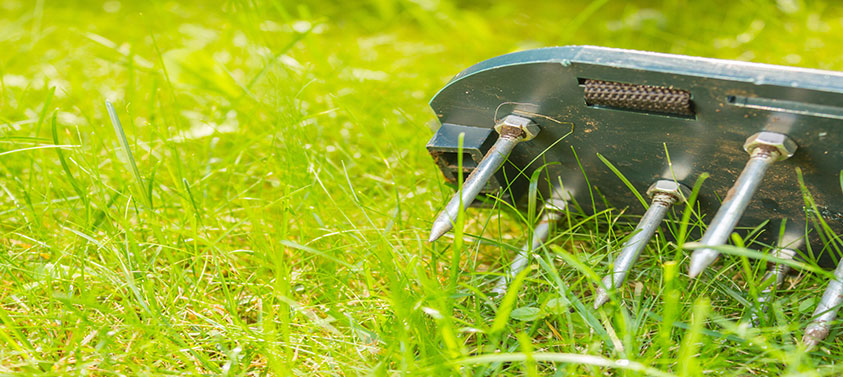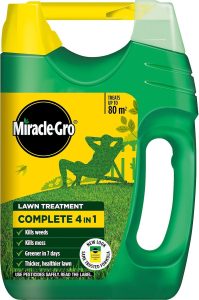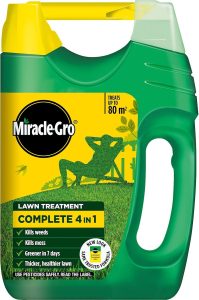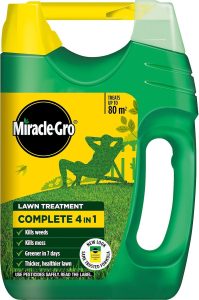Curious about how your neighbour keeps their lawn looking so perfect? Fed up with seeing pristine lawns on television? Do you frequently look at your own lawn and wonder why it looks so rough?
If you answered yes to one or all of these, it may be time to aerate your lawn. Either electrical or manual, an aerator is an essential piece of equipment if you want a healthy-looking lawn. An aerator works by making room for air to penetrate the deeper parts of the lawn, breaking up compacted soil and improving overall air flow.
Our top pick
ABREOME Lawn Aerator
OK, so it goes without saying that this aerator was easily the most fun one to use!
Simply strapped to our garden boots, we were able to literally make aeration a walk in the park (or back yard in this case!). With a one size fits all design and with the benefit of combining a workout with improving your lawn, whats not to like?
Made from a sturdy plastic that doesn’t buckle and with hard, metal spikes that penetrated our soil with the use of our body weight, this cheap and simple design is nothing short of genius and could be used in gardens of any size at al.
Storage is a breeze as they are no larger than a pair of shoes but, one little detail that we have to mention is that you may need to adjust them a few times as you use them.
- Strong and sturdy
- New and improved design
- A green, magnificent lawn
- One Size Fits All
- Improve muscle tone
Prices pulled from the Amazon Product Advertising API on:
Product prices and availability are accurate as of the date/time indicated and are subject to change. Any price and availability information displayed on [relevant Amazon Site(s), as applicable] at the time of purchase will apply to the purchase of this product.
What is a lawn aerator?
You have probably seen an aerator in your day to day; they work easily and have either one or a set of spikes that go into the soil, allowing air, water and nutrients to get in. The main purpose is to avoid your soil becoming too compact without back breaking digging. Plants and grass exposed to
aeration often grow better as the roots have more air and are able to get nutrients at the roots.
Symptoms of needing an aerated lawn
Unsure if you need a lawn aerator? The following signs are ways to determine if your lawn (and
plants) are suffering from too little air.
Your lawn looks like a pond after heavy rain
You drive across your lawn frequently with a car or other motorised vehicles.
It hard to stick poles or other bits of garden equipment into the soil
Your soil has a heavy clay content
You can see that the soil is compacted- it appears smooth with minimal give when pushed.
Bare patches of soil in your lawn
Choosing an aerator for your lawn
Like most things in life, the more power that your aerator has, the easier it will cope with harder soil. This is key and some smaller aerators may not last long, and will break after a few uses, due to excess soil compaction.
How do you choose the right aerator for your garden?
Blade width– The wider the blade width and the wider the aerator is, the less time it will take you to aerate your lawn. If your garden has bushes, trees and other plant life, you may need to scale this down, as a larger aerator is harder to manoeuvre around plants and pots.
Material– typically, aerators are usually plastic or metal.
Plastic is lighter and obviously is not subject to corrosion, but this material is not as strong as metal, so you will lose some power.
Knives– Does the aerator you are choosing have knives? Some have spikes or needles that are designed to pierce the ground, while others are built with special knives that clear old weeds and grass, to improve the overall appearance of your lawn.
Of course, you should always consider the size of your lawn in relation to your aerator too and determine how much weight you can move comfortably.
When to use a lawn aerator
There is a key to getting this right!
Firstly, try to ensure that your lawn is free from weeds; if you don’t, your aerator will spread them all over your lawn and soon, you will have a weed jungle!
If your lawn is new, avoid aerating for a year and try to use an aerator before you are adding any kind of nutrient feed to the soil. Remember, you don’t want to do too much to your lawn all at once and patience is key for a gorgeous lawn!
If the weather is hot and dry, do not use an aerator until there is some moisture in the soil. Doing so will make the soil drier and your grass will turn brown. Instead, aim to use your aerator when your
Types of aerator
Just like every other piece of garden equipment, there are different aerators suited to every garden, grass type and budget but they can be divided nicely into 2 groups; mechanical aerators and those that have motors that run on either electric or petrol.
Electrical aerators
If you have a small garden that you just want to spruce up a bit, your best bet is to go for an electrical lawn aerator as all it requires is a plug.
Usually lighter and easier to maintain, these are the most popular aerators on the market.
Gas aerators
Suitable if you are running a gardening company or are blessed with an enormous lawn, gas aerators provide a more powerful aeration and are able to cover more land.
These aerators tend to be heavier and costlier to maintain but, on the plus side, they pack a heck of a punch!
Manual aerators
Probably the type that most people could recognise at a first glance is the manual aerator.
Walking across your lawn with this option enables the spikes and the knives to do their work.
So, for this review, we used 5 aerators and assessed their ability to improve the quality of our lawn; we have heavy, clay soil, which is compacted and, frankly, is quite tough on the old wrists to try to break up manually.
Here is what we learned and what we found out.
UPP Manual Rolling Lawn Aerator
As it says in the title, this aerator is manual, with its rolling barrel design and large knives, this aerator looks up to the task of our lawn!
Stable, easy to use and requiring minimal pressure to break into the soil, this little aerator broke through our clay soil without issue and did not cause strain on the upper body. Easy to clean after usage, we found the simple design pleasing.
However, it is worth noting that we did use this aerator after a period of quite extensive rain, meaning that it may not have been as effective if the lawn was harder or had more condensed soil due to drier conditions. But, for the price of this little fella, we have to say, we can’t really falter it; it is lightweight, stores easily and also makes aerating our garden a walk in our garden!
- Rolling lawn aerator. 42 cm wide and a diameter of 21 cm incl. nails - length of nails 3.5 cm
- Even large lawns are not a problem - a total of 27 nails ensure a good result and aeration of the grass ! Increases the water flow on the roots and grass for better & denser grass growth
- Better supply of the lawn roots with more oxygen and thus significantly improved breathing of the lawn. Improves nutrient uptake - Scarify or aerate
- 100 cm long handle, which can be disassembled with 2 handles for storage - rubberized handle ensures non-slip and easier working
- Solid steel construction. Dim.: Handle:110 cm | Roll: 42 cm wide, ∅ 21 cm | 27 Nails each 3,5 cm
Prices pulled from the Amazon Product Advertising API on:
Product prices and availability are accurate as of the date/time indicated and are subject to change. Any price and availability information displayed on [relevant Amazon Site(s), as applicable] at the time of purchase will apply to the purchase of this product.
Hyundai 210cc 400mm Petrol Lawn Scarifier & Aerator
Perfect for small or medium lawns, this petrol aerator is very powerful and takes the push and pull out of aerating.
With a bag for catching all the bits of grass and moss we encountered in our lawn, this aerator was mess free and easy to use. However, as with most things that run on petrol, it was heavier than the other aerators we used and was a bit fiddly to initially set up.
Also, the spring tines were surprisingly breakable and, oddly enough, it was very hard to track down replacements, meaning that this aerator was hard to use the second time round. Also, given its size, you may need to get a bigger shed to store it!
But, with the adjustable height and adjustable strength settings to customise it to your garden, it was hard to really fault this aerator.
- Hyundai 210cc 4-Stroke OHV petrol engine, providing easy starting with low fuel consumption
- Variable Height Adjustment
- Easy to remove spacious 45L grass and moss collector
- 19 hardened steel blades specially designed to remove moss.
Prices pulled from the Amazon Product Advertising API on:
Product prices and availability are accurate as of the date/time indicated and are subject to change. Any price and availability information displayed on [relevant Amazon Site(s), as applicable] at the time of purchase will apply to the purchase of this product.
ABREOME Lawn Aerator
OK, so it goes without saying that this aerator was easily the most fun one to use!
Simply strapped to our garden boots, we were able to literally make aeration a walk in the park (or back yard in this case!). With a one size fits all design and with the benefit of combining a workout with improving your lawn, whats not to like?
Made from a sturdy plastic that doesn’t buckle and with hard, metal spikes that penetrated our soil with the use of our body weight, this cheap and simple design is nothing short of genius and could be used in gardens of any size at al.
Storage is a breeze as they are no larger than a pair of shoes but, one little detail that we have to mention is that you may need to adjust them a few times as you use them.
- Strong and sturdy
- New and improved design
- A green, magnificent lawn
- One Size Fits All
- Improve muscle tone
Prices pulled from the Amazon Product Advertising API on:
Product prices and availability are accurate as of the date/time indicated and are subject to change. Any price and availability information displayed on [relevant Amazon Site(s), as applicable] at the time of purchase will apply to the purchase of this product.
Kingfisher RC401 Pro Gold Lawn Aerator
Another manual aerator, much like the aerator shoes from the last review, relies on body weight to get it into motion. So, there is no force required.
Simple to store in a shed and very cost efficient, this aerator broke up even the densest areas of compacted soil in our garden, but, unlike the aerator shoes, this was a bit more of a task! So, it is truly a workout mixed with a garden sprucing.
But, unfortunately, you get what you pay for; the tines on the aerator, even though they were meant to be hardy, broke off during the first usage. So, it seems that this aerator was not really built to last. Also, as the plugs were moveable, they kept popping off as we went around the garden, meaning the process took twice as long! But, as we said, you get what you pay for.
- Ideal for the professional gardener
- Easily stores away, robust design
- 5 prong lawn aerator
- Weight : 2.16 Kg
- Brand : Kingfisher
Prices pulled from the Amazon Product Advertising API on:
Product prices and availability are accurate as of the date/time indicated and are subject to change. Any price and availability information displayed on [relevant Amazon Site(s), as applicable] at the time of purchase will apply to the purchase of this product.
Conclusions
Overall, it seems the aerator market is dominated by manual options and this can make the task a bit tougher on the wrists and upper body.
However, it goes without saying that when it comes to picking a favourite, regardless of how much fun they were to use, the best aerator was definitely the Abreome lawn aerator. Cheap, effective and requiring no upper body strength, these could be used by anyone for making their garden lawn
greener.
But, aside from giggles in relation to use, the Abreome was also easy to store and showed no signs of breakage; we have used it in our front garden too to break up the clay soil and it was just as good at that task, even though we are certain that soil is more compacted and prone to sticking to itself. So,
it seems if you are looking for an aerator to take the chore out of aerating a garden, opt for one that uses body weight as leverage, comes in one part (requires no assembly if possible) and allows for ease of use, with no fiddly bits required.




